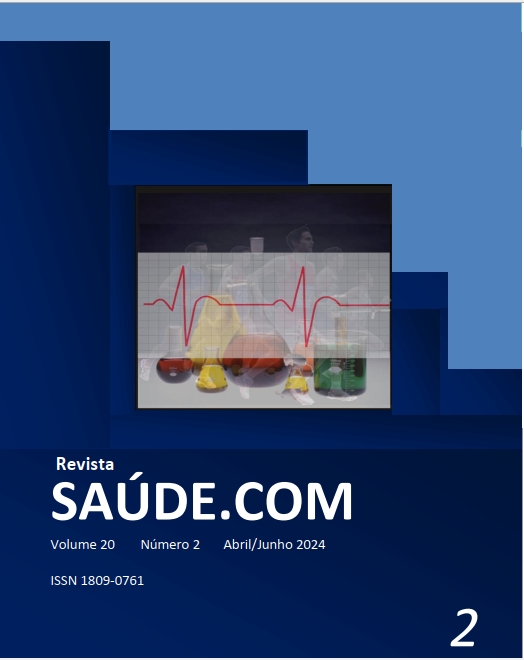SOCIAL AND BIOLOGICAL DETERMINANTS OF THE OCURRENCE OF PROSTATE CANCER IN INDIVIDUALS TREATED AT THE HOSPITAL NAVAL DE SALVADOR
DOI:
https://doi.org/10.22481/rsc.v20i2.13541Palabras clave:
Prostatic Neoplasms, Lipids, Health ProfileResumen
Occurrence of prostate cancer is associated with ethnic and biological factors. There are studies that do not consider the lipid profile as a biomarker and disagree that inequalities and ethnic/racial inequity interfere with the development of the disease. This studyaims to identify the association between social and biological determinants and the occurrence of prostate cancer. This study is a clinical cross-sectional study with 147 men (aged 32 to 94 years old) treated at the Hospital Naval de Salvador (Brazil) for a period of 5 years (2015 to 2020). Sociodemographic data were obtained through semi-structured interviews. Clinical data were collected from medical records, with the following biomarkers: total cholesterol, LDL, HDL and TG. Poisson Regression with Variance was used to estimate PR and 95%CI between outcome and exposure variables(Stata Software, version 12.0). Most patients were men over 61 years old, self-declared black or brown, and with a low level of education. It was observed that men aged over 60 years [PR=1,05; 95%CI= (1,04-1,06) ], with plasma cholesterol > 240 mg/dL [RP: 2.04; 95%CI= (1,03-4,39) ] and who do not use medication [PR=1,31; 95%CI= (1,05-1,63) ] were more likely to have prostate cancer when compared to the reference group. Thus, it is concluded that social and biological factors are relevant for prevention and early detection of the disease and support a better targeting of care, enabling better quality of life.
Descargas
Citas
DeSantis CE, Siegel RL, Sauer AG, Miller KD, Fedewa SA, Alcaraz KI, et al. Cancer statistics for African Americans, 2016: Progress and opportunities in reducing racial disparities. CA: A CancerJournal for Clinicians. 2016;66(4):290–308. Disponível em: https://doi.org/10.3322/caac.21340. Acesso em: 17 jul. 2023.
Bach PB, Schrag D, Brawley OW, Galaznik A, Yakren S, Begg CB. Survival of Blacks and Whites After a Cancer Diagnosis. . Journal of the American Medical Association. 2002;287(16):2106-2113. Disponível em: https://doi.org/10.1001/jama.287.16.2106. Acesso em: 17 jul. 2023.
Bairros FS de, Meneghel SN, Olinto MTA. Citopatológico e exame de mama: desigualdade de acesso para mulheres negras no sul do Brasil. Epidemiologia e Serviços de Saúde. 2008;17(2):138-141. Disponível em: https://doi.org/10.5123/S1679-49742008000200011. Acesso em: 17 jul. 2023.
Goldson A,Henschke U,Leffall LD, Schneider RL. Is there a genetic basis for the differences in cancer incidence between Afro-Americans and Euro-Americans?.Journal of the National Medical Association. 1981;73(8):701–706. Disponívelem: https://www.ncbi.nlm.nih.gov/pmc/articles/PMC2552686/. Acessoem: 17 jul. 2023.
Kitahara CM, Berrington de González A, Freedman ND, Huxley R, Mok Y, Jee SH, et al. Total Cholesterol and Cancer Risk in a Large Prospective Study in Korea. JournalofClinicalOncology. 2011;29(12):1592–1598. Disponível em: https://doi.org/10.1200/JCO.2010.31.5200. Acesso em: 17 jul. 2023.
De Souza ABC, Guedes HG, Oliveira VCB, De Araújo FA, Ramos CCO, Medeiros KCP,et al. High incidence of prostate cancer metastasis in Afro-Brazilian men with low educational levels: A retrospective observational study. BMC Public Health. 2013;13(1):8–11. Disponível em: https://doi.org/10.1186/1471-2458-13-537. Acesso em: 17 jul. 2023.
Kobayashi M, Sasaki S, Hamada GS, Tsugane S. Serum n-3 fatty acids, fish consumption and cancer mortality in six Japanese populations in Japan and Brazil. JapaneseJournalofCancerResearch. 1999;90(9):914–921. Disponível em: https://doi.org/10.1111/j.1349-7006.1999.tb00835.x. Acesso em: 17 jul. 2023.
Roche. Cobas Integra® 400 plus. Disponível em: http://medica-ne.com.br/archives/ Sorologia-folder-Integra400plus-site.pdf. Acesso em: 17 jul. 2023.
INCA - Instituto Nacional de Câncer.Estatísticas de câncer [Internet]. 2020. Disponível em: https://www.inca.gov.br/numeros-de-cancer. Acessoem: 17 jul. 2023.
Aunan JR, Cho WC, Søreide K. The Biology of Aging and Cancer: A Brief Overview of Shared and Divergent Molecular Hallmarks. AgingandDisease. 2017;8(5):628-642. Disponível em: https://doi.org/10.14336/AD.2017.0103. Acesso em: 17 jul. 2023.
Moskalev AA, Shaposhnikov MV, Plyusnina EN, Zhavoronkov A, Budovsky A, Yanai H, et al. The role of DNA damage and repair in aging through the prism of Koch-like criteria. AgeingResearch Reviews. 2013;12(2):661–684. Disponível em: https://doi.org/10.1016/j.arr.2012.02.001. Acesso em: 17 jul. 2023.
Feng L, Nian S, Tong Z, Zhu Y, Li Y, Zhang C, et al. Age-related trends in lipid levels: a large-scale cross-sectional study of the general Chinese population. BMJ open. 2020;10(3): e034226. Disponível em: https://doi.org/10.1136/bmjopen-2019-034226. Acesso em: 17 jul. 2023.
Zhang P, Su Q, Ye X, Guan P, Chen C, Hang Y, et al. Trends in LDL-C and Non-HDL-C Levels with Age. Aginganddisease. 2020;11(5):1046-1057. Disponível em: https://doi.org/10.14336/AD.2019.1025. Acesso em: 17 jul. 2023.
Barros M, Silva VRS, Santos GB, Hughes A, Silveira MA. Prevalence of prostate adenocarcinoma according to race in an university hospital. 2003;29(4):306–312. Disponível em: https://doi.org/10.1590/S1677-55382003000400004. Acesso em: 17 jul. 2023.
Romero FR, Romero AW, Almeida RMS de, Filho RT. The prevalence of prostate cancer in Brazil is higher in Black men than in White men: systematic review and meta-analysis. International Brazilian Journal of Urology. 2012;38(4):440–447. Disponívelem: https://doi.org/10.1590/S1677-55382012000400002. Acessoem: 17 jul. 2023.
Jones ALC, Chinegwundoh F. Update on prostate cancer in black men within the UK. Ecancermedicalscience. 2014;8:1–10. Disponível em: https://doi.org/10.3332/ecancer.2014.455. Acesso em: 17 jul. 2023.
Albright FS, Stephenson RA, Agarwal N, Cannon-Albright LA. Relative Risks for Lethal Prostate Cancer Based on Complete Family History of Prostate Cancer Death. The Prostate. 2017; 77(1):41–8. Disponível em: https://doi.org/10.1002/pros.23247. Acesso em: 17 jul. 2023.
Moura FV de M, Rabelo JB. Aspectos Socioculturais que envolvem o Câncer de Próstata na Ótica dos Usuários e Assistentes Sociais. Revista Brasileira de Cancerologia. 2019;65(2): 1-11. Disponível em: https://doi.org/10.32635/2176-9745.RBC.2019v65n2.125. Acesso em: 17 jul. 2023.
Viana M, Martins JT, Maciel AA, Marcon SS, Ribeiro RP. Perfil Epidemiológico Do Homem Com Câncer De Próstata Atendido Em Um Hospital Universitário. Cogitare Enfermagem. 2014; 19(2): 333–340. Disponível em: http://dx.doi.org/10.5380/ce.v19i2.31540. Acesso em: 17 jul. 2023.
Gonçalves IR, Padovani C, Popim RC. Caracterização epidemiológica e demográfica de homens com câncer de próstata. Ciência & Saúde Coletiva. 2008;13(4):1337–1342.Disponível em: https://doi.org/10.1590/S1413-81232008000400031. Acesso em: 17 jul. 2023.
Rodrigues RS, Sá RG de, Zangrande C. Perfil epidemiológico dos portadores de câncer de próstata em tratamento na unidade de referência em oncologia do município de Sinop/MT. Enfermagem Brasil. 2016; 15 (4): 181-189. Disponível em: https://doi.org/10.33233/eb.v15i4.497. Acesso em: 17 jul. 2023.
Pudrovska T, Anishkin A. Clarifying the Positive Association Between Education and Prostate Cancer. JournalofApplied Gerontology. 2015;34(3):293–316.Disponível em: https://doi.org/10.1177/0733464812473798. Acesso em: 17 jul. 2023.
Coughlin SS. A review of social determinants of prostate cancer risk, stage, and survival. ProstateInternational. 2020;8(2):49-54.Disponível em: https://doi.org/10.1016/j.prnil.2019.08.001. Acesso em: 17 jul. 2023.
Eichholzer M, Stähelin HB, Gutzwiller F, Lüdin E, Bernasconi F. Association of low plasma cholesterol with mortality for cancer at various sites in men: 17-y follow-up of the prospective Basel study. The American Journal of Clinical Nutrition. 2000;71(2):569–74. Disponívelem: https://doi.org/10.1093/ajcn/71.2.569. Acesso em: 17 jul. 2023.
Heir T, Falk RS, Robsahm TE, Sandvik L, Erikssen J, Tretli S. Cholesterol and prostate cancer risk: a long-term prospective cohort study. BMC Cancer. 2016;16(1):1-9. Disponível em: http://dx.doi.org/10.1186/s12885-016-2691-5. Acesso em: 17 jul. 2023.
YuPeng L, YuXue Z, PengFei L, Cheng C, YaShuang Z, DaPeng L, et al. Cholesterol Levels in Blood and the Risk of Prostate Cancer: A Meta-analysis of 14 Prospective Studies. CancerEpidemiologyBiomarkers&Prevention. 2015;24(7):1086–1093. Disponível em: https://doi.org/10.1158/1055-9965.EPI-14-1329. Acesso em: 17 jul. 2023.
Jamnagerwalla J, Howard LE, Vidal AC, Moreira DM, Castro-Santamaria R, Andriole GL, et al. Mp14-03 Higher Cholesterol Is Linked With Increased Risk of High-Grade Prostate Cancer: Results From the Reduce Study. JournalofUrology. 2017;197(4S):e163. Disponível em: http://dx.doi.org/10.1016/j.juro.2017.02.467. Acessoem: 17 jul. 2023.
Mondul AM, Weinstein SJ, Virtamo J, Albanes D. Serum total and HDL cholesterol and risk of prostate cancer. Cancer Causes andControl. 2011;22(11):1545–1552.Disponível em: https://doi.org/10.1007/s10552-011-9831-7. Acesso em: 17 jul. 2023.
Descargas
Publicado
Cómo citar
Número
Sección
Licencia
Derechos de autor 2024 Saúde.com

Esta obra está bajo una licencia internacional Creative Commons Atribución 4.0.







